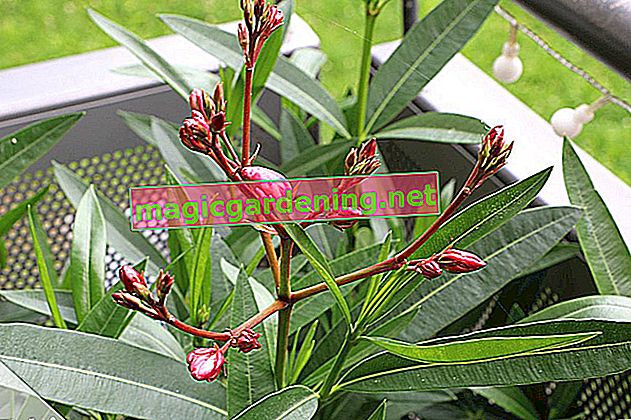
Particularly easy: Propagation via cuttings
The vegetative propagation of the oleander is particularly easy if you root the cuttings that arise every year when pruning either in a water glass or in lean soil. In principle, all shoots can be used as cuttings, provided they are at least 15 centimeters long. However, rooting works best with young, not yet woody branches. These should be cut between June and September.
- Cut off the shoots just below a leaf knot.
- From there, the cutting forms roots and new shoots.
- Ideally, the cuttings are between 15 and 25 centimeters long
- and still have soft, green wood.
- The cut surface should be slightly sloping to make it easier for the cutting to absorb water.
- Use a sharp and clean knife for this.
- A pair of scissors, on the other hand, is unsuitable because you only squeeze the conductor paths with them.
- Remove the lower pairs of leaves, leaving only the top one.
- Place the cutting in a glass with fresh, lukewarm water.
- This should be changed daily.
- Put the glass in a bright and warm place,
- however, avoid direct sunlight.
- The first fine roots form after about four weeks.
- If there are enough roots, the plant can be planted in a humus-rich substrate.
also read
- Oleander is easy to propagate using cuttings
- This is how easy it is to propagate pampas grass
- How can a hornbeam hedge be propagated yourself?
Instead of a water glass, you can also put the cuttings in a lean growing medium (€ 9.05 on Amazon *). However, keep the substrate evenly moist and ensure high humidity. You can achieve this by putting a disposable glass or a cut-off PET bottle over the cutting.
Works great on older plants: divide oleanders
Oleander grows very bushy and usually has three or even more strong main shoots. Oleanders are easy to divide the next time they are repotted by cutting through the roots so that each new plant receives at least one of these main shoots. Then plant the individual pieces in new containers. Oleander should be divided as early as possible in the year, before the flowers form - it is best to carry out the procedure in April. Then the divided individual plants have sufficient opportunity to form new flowers and the flowering frenzy does not fail this season.
Growing oleanders from seeds
Oleanders in particular form seed pods if the dead shoots are not cut off. From these you can obtain the seeds you need for breeding, but the seedlings obtained from them will most likely look different from the mother plant - mutations and the emergence of unknown genetic material is not the exception in this type of propagation, but the rule. Since it doesn't get cold in winter in the oleander's home, you don't need to stratify the seeds. Instead, you can sow them right away. However, the best time to sow is late winter or early spring, ie in February or March. The seeds germinate best in an indoor greenhouse in a light and warm location. However, don't lose patienceif after several weeks there are still no seedlings to be seen: Sometimes it takes a while.
- Use poor potting soil or coconut substrate (“Kokohum”) for growing.
- Fill this into a shallow bowl with holes on the bottom,
- there any excess irrigation water can run off.
- Let the seeds soak for at least six hours before sowing.
- Use lukewarm water for this.
- Cover the seeds only very lightly with sieved soil,
- because oleander is a light germ.
- Keep the substrate evenly moist.
- An atomizer is particularly suitable for this.
The young plants can be converted into a nutrient-rich substrate as soon as they have developed at least one other pair of leaves in addition to the two cotyledons. Make sure that the seedlings are not too close to one another in the seedling tray, otherwise the fine roots can get tangled up and you will not get the young plants transplanted into individual planters without damage.
Tips
If you cut cuttings, dead shoots or seed pods on the oleander, you should never do this without gloves! All parts of the plant in the flowering bush are highly poisonous, which is especially true for the milky sap. If it comes into contact with the skin, this can cause irritation (e.g. rashes), but - if the juice gets into open wounds and thus into the bloodstream - it can also cause symptoms of poisoning.








